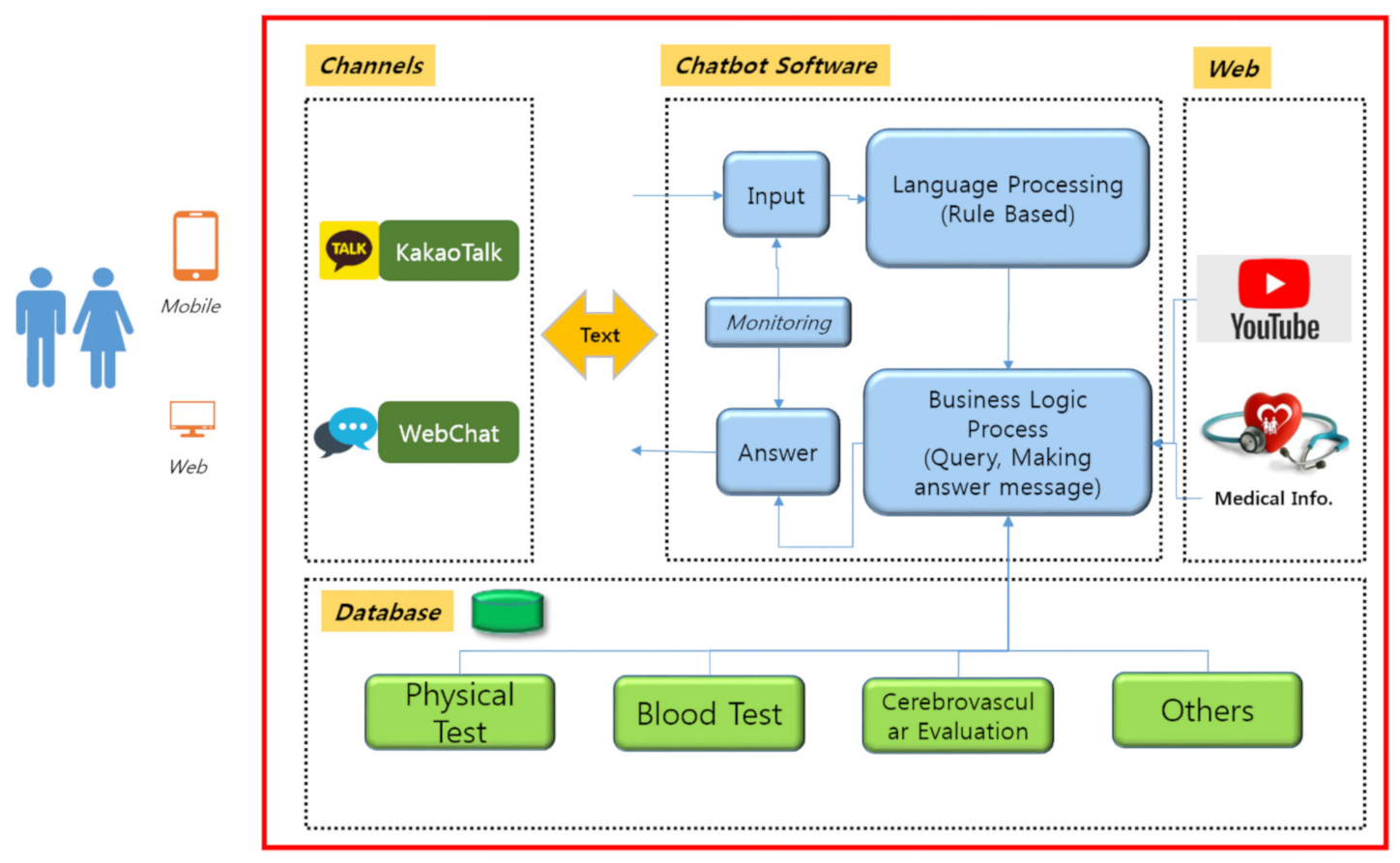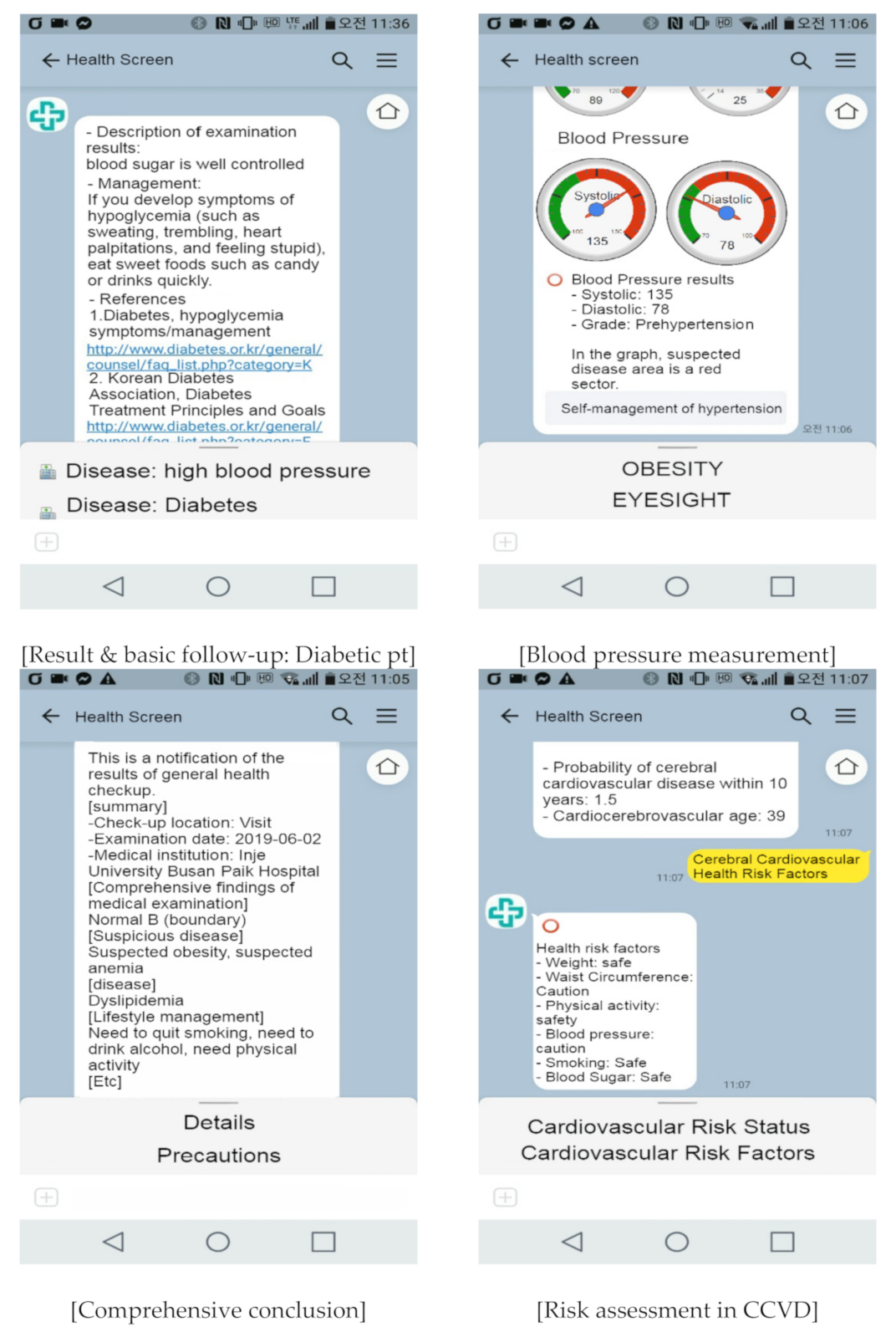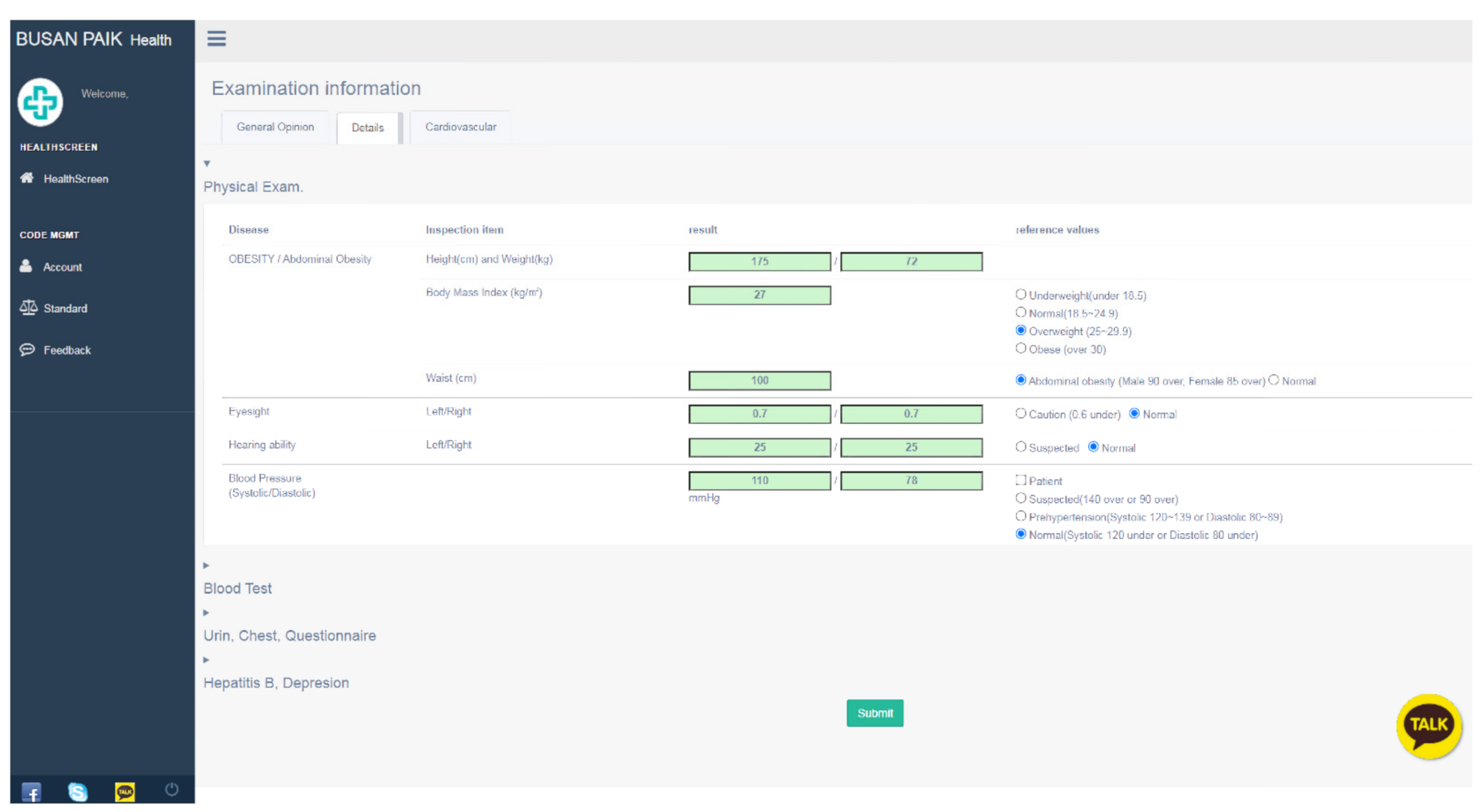Development of a Chatbot Program for Follow-Up Management of Workers’ General Health Examinations in Korea: A Pilot Study
Abstract
1. Introduction
2. Materials and Methods
2.1. Setting and Participants
2.2. Chatbot Program Development
- Requirements analysis: Define business requirements for program development.
- Scenario flow definition: Define the flow of core tasks to which the program is applied and the flow design for providing examination results.
- Database construction: Design and build the schema for the examination results and additional explanation database. At this time, construct images and videos that will be useful for explaining the examination results.
- Channel establishment: Set the channel where the user and chatbot will meet.
- Chatbot program development: Develop a content-provided chatbot program and a chatbot program that extracts and provides necessary answers.
2.3. Program Content Development
2.4. Effectiveness Survey and Applicability Interview
2.5. A Data Analysis
3. Results
3.1. Chatbot Program Contents
3.2. Effectiveness Survey
3.3. Applicability to the Occupational Health Service
4. Discussion
5. Conclusions
Author Contributions
Funding
Institutional Review Board Statement
Informed Consent Statement
Data Availability Statement
Conflicts of Interest
Appendix A
| Please mark (✓) the appropriate place for the following question after using the chatbot follow-up program | ||||
| 1. Did you understand the contents explained in the chatbot follow-up program? | ||||
| ① excellent | ② good | ③ average | ④ bad | ⑤ terrible |
| 2. Was the contents of the chatbot follow-up management program specific so that it could be used realistically? | ||||
| ① excellent | ② good | ③ average | ④ bad | ⑤ terrible |
| 3. Was the chatbot follow-up program convenient to use? | ||||
| ① excellent | ② good | ③ average | ④ bad | ⑤ terrible |
| 4. Was the composition of the overall screen and buttons arranged in an easy to understand way? | ||||
| ① excellent | ② good | ③ average | ④ bad | ⑤ terrible |
| 5. Do you think it is necessary to receive specific results of your health examination through an app: such as a chatbot follow-up program? | ||||
| ① excellent | ② good | ③ average | ④ bad | ⑤ terrible |
| 6. Do you think the chatbot follow-up program can contribute to personal health promotion? | ||||
| ① excellent | ② good | ③ average | ④ bad | ⑤ terrible |
| 7. What is your overall satisfaction level when using the chatbot follow-up program? | ||||
| ① excellent | ② good | ③ average | ④ bad | ⑤ terrible |
| 8. Please give your opinion if there is a part that needs improvement in the chatbot follow-up program | ||||
References
- Feightner, J.W.; Battista, R.N.; Dingle, J.L. Periodic health examination. In Textbook of Family Medicine, 6th ed.; Rakel, R.E., Ed.; Saunders: Philadelphia, PA, USA, 2002; pp. 159–209. [Google Scholar]
- Kang, Y.J.; Myong, J.P.; Eom, H.S.; Choi, B.W.; Park, J.H.; Kim, E.A. The current condition of the workers’general health examination in South Korea: A retrospective study. Ann. Occup. Environ. Med. 2017, 29. [Google Scholar] [CrossRef]
- Lee, W.C.; Lee, S.Y. National health screening program of Korea. J. Korean Med. Assoc. 2010, 53, 363–370. [Google Scholar] [CrossRef]
- Lee, W.C.; Lee, S.Y.; Lee, K.J.; Lee, J.H.; Lee, H.J. The Strategy to Set up the Follow-up System for the Positives and the High Risk Group Detected by National Screening Program; Report No.: Strategy 07-39; Ministry of Health and Welfare: Sejong-si, Korea, 2007; pp. 12–14. Available online: https://scienceon.kisti.re.kr/srch/selectPORSrchReport.do?cn=TRKO201500007331 (accessed on 27 July 2020).
- Goetzel, R.Z.; Ozminkowski, R.J.; Bruno, J.A.; Rutter, K.R.; Isaac, F.; Wang, S. The long-term impact of Johnson & Johnson’ Health & Wellness Program on employee health risks. J. Occup. Environ. Med. 2002, 44, 417–424. [Google Scholar]
- Low, V.; Gebhart, B.; Reich, C. Effects of a worksite program to improve the cardiovascular health of female health care workers. J. Cardiopulm. Rehabil. Prev. 2015, 35, 342–347. [Google Scholar] [CrossRef]
- Merrill, R.M.; Sloan, A. Effectiveness of a health promotion program among employees in a western United States school district. J. Occup. Environ. Med. 2014, 56, 639–644. [Google Scholar] [CrossRef][Green Version]
- Cho, B.; Ahn, E.M. Present Status and Problems of Health Screening Program in Korea. Health Welfare Policy Forum 2013, 198, 48–54. [Google Scholar]
- Schachner, T.; Keller, R.; Wangenheim, F. Artificial Intelligence-Based Conversational Agents for Chronic Conditions: Systematic Literature Review. J. Med. Internet Res. 2020, 22, e20701. [Google Scholar] [CrossRef]
- Tsai, C.; Wu, J. Using neural network ensembles for bankruptcy prediction and credit scoring. Expert Syst. Appl. Pergamon 2008, 4, 2639–2649. [Google Scholar] [CrossRef]
- Davenport, T.; Guha, A.; Grewal, D.; Bressgott, T. How artificial intelligence will change the future of marketing. J. Acad. Mark. Sci. 2019, 48, 24–42. [Google Scholar] [CrossRef]
- Medical News. Available online: http://www.mdon.co.kr/news/article.html?no=22077 (accessed on 13 June 2020).
- ChatBottle. Available online: https://chatbottle.co/bots/health-tap (accessed on 8 July 2020).
- Babylon. Available online: https://www.babylonhealth.com (accessed on 21 July 2020).
- Bibault, J.E.; Chaix, B.; Guillemassé, A.; Cousin, S.; Escande, A.; Perrin, M.; Pienkowski, A.; Delamon, G.; Nectoux, P.; Brouard, B. A Chatbot Versus Physicians to Provide Information for Patients With Breast Cancer: Blind, Randomized Controlled Noninferiority Trial. J. Med. Internet Res. 2019, 21, e15787. [Google Scholar] [CrossRef] [PubMed]
- Greer, S.; Ramo, D.; Chang, Y.J.; Fu, M.; Moskowitz, J.; Haritatos, J. Use of the Chatbot “Vivibot” to Deliver Positive Psychology Skills and Promote Well-Being AmongYoung People After Cancer Treatment: Randomized Controlled Feasibility Trial. JMIR Mhealth Uhealth 2019, 7, e15018. [Google Scholar] [CrossRef] [PubMed]
- Park, S.; Choi, J.; Lee, S.; Oh, C.; Kim, C.; La, S.; Lee, J.; Suh, B. Designing a Chatbot for a Brief Motivational Interview on Stress Management: Qualitative Case Study. J. Med. Internet Res. 2019, 21, e12231. [Google Scholar] [CrossRef]
- Hoermann, S.; McCabe, K.L.; Milne, D.N.; Calvo, R.A. Application of Synchronous Text-Based Dialogue Systems in Mental Health Interventions: Systematic Review. J. Med. Internet Res. 2017, 19, e267. [Google Scholar] [CrossRef] [PubMed]
- Perski, O.; Crane, D.; Beard, E.; Brown, J. Does the addition of a supportive chatbot promote user engagement with a smoking cessation app? An experimental study. Digit. Health 2019, 9, 1–13. [Google Scholar] [CrossRef]
- Avila-Tomas, J.F.; Olano-Espinosa, E.; Minué-Lorenzo, C.; Martinez-Suberbiola, F.J.; Matilla-Pardo, B.; Serrano-Serrano, M.E.; Escortell-Mayor, E.; the Group Dej@lo. Effectiveness of a chat-bot for the adult population to quit smoking: Protocol of a pragmatic clinical trial in primary care (Dejal@). BMC Med. Inform. Decis. Mak. 2019, 19, 249. [Google Scholar] [CrossRef] [PubMed]
- Smiciklas, M. The Power of Infographics: Using Pictures to Communicate and Connect with Your Audiences.; Que Pub: Indianapolis, IN, USA, 2012; p. 199. [Google Scholar]
- McCrorie, A.D.; Donnelly, C.; McGlade, K.J. Infographics: Healthcare Communication for the Digital Age. Ulst. Med. J. 2016, 85, 71–75. [Google Scholar]
- Houts, P.S.; Doak, C.C.; Doak, L.G.; Loscalzo, M.J. The role of pictures in improving health communication: A review of research on attention, comprehension, recall, and adherence. Patient Educ. Couns. 2006, 61, 173–190. [Google Scholar] [CrossRef]
- Beldad, A.D.; Hegner, S.M. Expanding the Technology Acceptance Model with the Inclusion of Trust, Social Influence, and Health Valuation to Determine the Predictors of German Users’ Willingness to Continue Using a Fitness App: A Structural Equation Modeling Approach. Int. J. Hum. Comput. Interact. 2018, 34, 882–893. [Google Scholar] [CrossRef]
- Cho, J.; Lee, H.E.; Quinlan, M. Complementary relationships between traditional media and health apps among american college students. J. Am. Coll. Health 2015, 63, 248–257. [Google Scholar] [CrossRef] [PubMed]
- Dennison, L.; Morrison, L.; Conway, G.; Yardley, L. Opportunities and challenges for smartphone applications in supporting health behavior change: Qualitative study. J. Med. Internet Res. 2013, 15, e86. [Google Scholar] [CrossRef]
- Park, M.J. Factors Affecting Intention to Use Smartphone Healthcare Applications. JKAIS 2017, 18, 143–153. [Google Scholar]
- Kim, Y.S. A Study on Activation of Occupational Safety and Health Agency for Reducing Industrial Accidents. J. Korean Soc. Hazard Mitig. 2009, 9, 67–70. [Google Scholar]
- Kowatsch, T.; Nißen, M.K.; Shih, I.; Rüegger, D.; Volland, D.; Filler, A.; Künzler, F.; Barata, F.; Haug, S.; Büchter, D.; et al. Text-based healthcare chatbots supporting patient and health professional teams: Preliminary results of a randomized controlled trial on childhood obesity. In Proceedings of the Persuasive Embodied Agents for Behavior Change (PEACH2017) Workshop, Co-Located with the 17th International Conference on Intelligent Virtual Agents (IVA 2017), Stockholm, Sweden, 27–30 August 2017. [Google Scholar] [CrossRef]



| Target ds | Specific Information | Source of Information |
|---|---|---|
| CCVD | 1. Definition of cardiocerebrovascular ds and preventive lifestyle | https://www.youtube.com/watch?v=HcM3pVhDLFY (accessed on 3 May 2019) |
| 2. Prevention of cardiocerebrovascular disease | https://www.youtube.com/watch?v=vttGkiDOQwc (accessed on 7 May 2019) | |
| 3. Early symptom of cardiocerebrovascular disease | http://www.stroke.or.kr/study/movie.php (accessed on 8 May 2019) | |
| obesity | 1. Effects of exercise in obesity | http://general.kosso.or.kr/html/?pmode=exerciseObesity (accessed on 15 May 2019) |
| 2. Various exercise methods | http://general.kosso.or.kr/html/?pmode=movie4 (accessed on 15 May 2019) | |
| 3. Dietary tips for weight control | http://general.kosso.or.kr/html/?pmode=nutritionTip (accessed on 15 May 2019) | |
| 4. Various managements of obesity (meal, exercise, treatment) | http://general.kosso.or.kr/html/?pmode=obesityCure# (accessed on 17 May 2019) | |
| 5. Eating habits of obesity by meal type | http://www.samsunghospital.com/home/healthInfo/content/contenView.do?CONT_SRC_ID=32373&CONT_SRC=HOMEPAGE&CONT_ID=4253&CONT_CLS_CD=001021005002 (accessed 17 May 2019) | |
| 6. Physical activity/nutrition management for obesity | https://www.youtube.com/watch?v=ltuIoi53nYw (accessed on 17 May 2019) | |
| drinking | 1. Moderate drinking and proper drinking method | https://www.youtube.com/watch?v=1U58J7Hy8Qg (accessed on 18 May 2019) |
| 2. Self-diagnosis of alcohol dependence | http://www.nosmokeguide.go.kr/lay2/program/S1T50C55/nosmoke/noSmoke_selftest/noSmoke_selftest1_2q.do (accessed on 18 May 2019). | |
| hypertension | 1. Definition of hypertension | https://www.youtube.com/watch?v=SL_kKGCyfdo(accessed on 2 June 2019) |
| 2. Complications of hypertension | https://www.youtube.com/watch?v=BFEPoWNln-8 (accessed on 2 June 2019) | |
| 3. Treatment(drug) of hypertension | https://www.youtube.com/watch?v=Kg_ds77-Y64 (accessed on 2 June 2019) | |
| 4. Lifestyle management for hypertensive patients | https://www.youtube.com/watch?time_continue=144&v=uPETHTb69E8 (accessed on 7 June 2019) | |
| 5. Exercise method for blood pressure control | https://www.youtube.com/watch?v=jwv62FFnBRs (accessed on 7 June 2019) | |
| 6. Diet to control blood pressure | https://www.youtube.com/watch?v=uvrPNIimWW4 (accessed on 7 June 2019) | |
| smoking | 1. Risk of smoking, smoking cessation effect, drug therapy | https://www.youtube.com/watch?v=8hpAmvjHpuk (accessed on 8 June 2019) |
| 2. Self-diagnosis of nicotine addiction | http://www.nosmokeguide.go.kr/lay2/program/S1T50C9/nosmoke/noSmoke_selftest/noSmoke_selftest1_1q.do (accessed on 8 June 2019). | |
| 3. Find a smoking cessation clinic(public health) | http://www.nosmokeguide.go.kr/lay2/program/S1T68C107/nosmoke/centermap/bogun_list.do (accessed on 8 June 2019). | |
| Diabetes | 1. Diabetes definition and classification | https://www.youtube.com/watch?time_continue=1&v=PyiZ_nPoFWo (accessed on 6 July 2019) |
| 2. Complications of diabetes | ||
| (1) diabetic foot | https://www.youtube.com/watch?v=Mhxc196ivUc (accessed on 6 July 2019) | |
| (2) Peripheral neuropathy | https://www.youtube.com/watch?v=Idr-BRKRlH4 (accessed on 8 July 2019) | |
| (3) Kidney complications | https://www.youtube.com/watch?time_continue=197&v=PN-afvhKEhI (accessed on 8 July 2019) | |
| 3. Diabetes medication | https://www.youtube.com/watch?v=KGYgHmqBIM0 (accessed on 8 July 2019) | |
| 4. Hypoglycemia symptoms and managements | http://www.diabetes.or.kr/general/counsel/faq_list.php?category=K (accessed on 10 July 2019) | |
| 5. Exercise in Diabetes | https://www.youtube.com/watch?time_continue=122&v=D2A0ZudD6Vo (accessed on 10 July 2019) | |
| 6. Diabetes Meal | http://www.diabetes.or.kr/general/food/index.php (accessed on 10 July 2019) | |
| Dyslipidaemia | 1. Types and meaning of cholesterol | http://www.lipid.or.kr/bbs/index.html?code=animation&category=1&gubun=&keyfield=&key=&mode=view&number=933 (accessed on 17 July 2019) |
| 2. Complications of dyslipidaemia | http://www.lipid.or.kr/bbs/index.html?code=animation&category=1&gubun=&keyfield=&key=&mode=view&number=931 (accessed on 17 July 2019) | |
| 3. Risk factors and treatment goals of dyslipidaemia | http://www.lipid.or.kr/bbs/index.html?code=animation&category=1&gubun=&keyfield=&key=&mode=view&number=929 (accessed on 19 July 2019) | |
| 4. Correcting lifestyle habits of dyslipidaemia | http://www.lipid.or.kr/bbs/index.html?code=animation&category=1&gubun=&keyfield=&key=&mode=view&number=930 (accessed on 19 July 2019) | |
| 5. Exercise of dyslipidaemia | http://www.lipid.or.kr/bbs/index.html?code=animation&category=1&gubun=&keyfield=&key=&mode=view&number=926 (accessed on 19 July 2019) | |
| 6. Diet for dyslipidaemia | http://www.lipid.or.kr/bbs/index.html?code=animation&category=1&gubun=&keyfield=&key=&mode=view&number=924 (accessed on 20 July 2019) | |
| Anaemia | 1. Comment on anaemia test results | https://youtu.be/aqxwwTln4jc (accessed on 23 July 2019) |
| 2. Causes, symptoms, and complications of anaemia | https://health.cdc.go.kr/healthinfo/biz/health/gnrlzHealthInfo/gnrlzHealthInfo/gnrlzHealthInfoView.do (accessed on 23 July 2019) | |
| 3. Anaemia and Meal Therapy | http://www.samsunghospital.com/home/healthInfo/content/contenView.do?CONT_SRC_ID=09a4727a80018c1c&CONT_SRC=CMS&CONT_ID=2318&CONT_CLS_CD=001020002 (accessed on 23 July 2019) | |
| 4. Anaemia medication | https://www.youtube.com/watch?v=qvvxdKn4y3U (accessed on 23 July 2019) | |
| Kidney disease | 1. The meaning of urine protein test | https://www.youtube.com/watch?v=t5KJk0v9ZZM (accessed on 21 August 2019) |
| 2. Serum creatinine and Implications of the GFR (Glomerular Filtration Rate) | https://www.youtube.com/watch?v=967CeHgF3rc (accessed on 21 August 2019) | |
| 3. Acute kidney disease | http://www.ksn.or.kr/sub10/sub01_03.html (accessed on 23 August 2019) | |
| 4. Chronic kidney disease | http://www.ksn.or.kr/sub10/sub01_02.html (accessed on 23 August 2019) | |
| 5. Diet management in kidney disease | https://www.dietitian.or.kr/work/business/kb_c_kidney_glomerulonephritis.do (accessed on 23 August 2019) | |
| Liver disease | 1. Means of liver function test | https://www.youtube.com/watch?v=mmOEl4z-G9I (accessed on 27 August 2019) |
| 3. Possible symptoms of liver damage | https://terms.naver.com/entry.nhn?docId=2704268&cid=55588&categoryId=55588&expCategoryId=55588 (accessed on 27 August 2019) | |
| 4. Definition and management of viral hepatitis | https://terms.naver.com/entry.nhn?docId=2704287&cid=55588&categoryId=55588 (accessed on 28 August 2019) | |
| 5. Alcoholic liver disease management | https://terms.naver.com/entry.nhn?docId=2704307&cid=55588&categoryId=55588&expCategoryId=55588 (accessed on 28 August 2019) | |
| 6. Standard of proper drinking amount | https://terms.naver.com/entry.nhn?docId=2704308&cid=55588&categoryId=55588&expCategoryId=55588 (accessed on 28 August 2019) | |
| 7. Liver health, exercise and weight control | https://terms.naver.com/entry.nhn?docId=2704346&cid=55588&categoryId=55588 (accessed on 29 August 2019) | |
| 8. Diet management of liver disease | https://www.dietitian.or.kr/work/business/kb_c_liver.do (accessed on 29 August 2019) |
| Characteristics | Participant (n) | Participant (%) | |
|---|---|---|---|
| Gender | male | 14 | 60.88 |
| female | 9 | 39.12 | |
| Age | 20–29 | 6 | 26.09 |
| 3–39 | 9 | 39.12 | |
| 4–49 | 6 | 26.09 | |
| 5–59 | 2 | 8.70 | |
| Content understanding | High | 17 | 73.91 |
| Moderate | 4 | 17.39 | |
| Low | 2 | 8.70 | |
| Content specificity | High | 18 | 78.26 |
| Moderate | 3 | 13.04 | |
| Low | 2 | 8.70 | |
| Convenience of use | High | 11 | 47.83 |
| Moderate | 7 | 30.43 | |
| Low | 5 | 21.74 | |
| Configuration convenience | High | 13 | 56.52 |
| Moderate | 4 | 17.39 | |
| Low | 6 | 26.09 | |
| Needs of Program | High | 21 | 91.30 |
| Moderate | 0 | 0.00 | |
| Low | 2 | 8.70 | |
| Contribution to health | High | 16 | 69.56 |
| Moderate | 5 | 21.74 | |
| Low | 2 | 8.70 | |
| Overall satisfaction | High | 14 | 60.87 |
| Moderate | 6 | 26.09 | |
| Low | 3 | 13.04 |
| Question | Answer |
|---|---|
| Difficulties of follow-up management in occupational health service | (1) In many cases, compliance with the follow-up management is poor for personal or business reasons. (2) Because the visit cycle is long, if you do not meet once, it will take a lot of time until the opportunity comes again. (3) There is not much time to explain the details of follow-up management. (4) It is not possible to confirm whether the workers perform the necessary follow-up management. |
| Evaluation of the chatbot program for follow-up ma nagement | (1) Methods of follow-up management are specific and there are a lot of videos such as YouTube, so it seems to help to understand the contents. (2) There are many visual tools such as graphs, so it is good to see results. (3) Because it is complicated to use, it seems that elderly workers will have difficulty using it. (4) Accessibility will be higher if questions and answers for interests are added. |
| Possibility of chatbot program for follow-up management in the occupational health service | (1) It is possible that the follow-up management information can be viewed on your smartphone at any time, so that the accessibility of the follow-up management can be improved. (2) It can be used as a material to explain the follow-up management contents to the target workers. (3) It can shorten the management time of workers in follow-up management. |
Publisher’s Note: MDPI stays neutral with regard to jurisdictional claims in published maps and institutional affiliations. |
© 2021 by the authors. Licensee MDPI, Basel, Switzerland. This article is an open access article distributed under the terms and conditions of the Creative Commons Attribution (CC BY) license (http://creativecommons.org/licenses/by/4.0/).
Share and Cite
Ye, B.J.; Kim, J.Y.; Suh, C.; Choi, S.P.; Choi, M.; Kim, D.H.; Son, B.C. Development of a Chatbot Program for Follow-Up Management of Workers’ General Health Examinations in Korea: A Pilot Study. Int. J. Environ. Res. Public Health 2021, 18, 2170. https://doi.org/10.3390/ijerph18042170
Ye BJ, Kim JY, Suh C, Choi SP, Choi M, Kim DH, Son BC. Development of a Chatbot Program for Follow-Up Management of Workers’ General Health Examinations in Korea: A Pilot Study. International Journal of Environmental Research and Public Health. 2021; 18(4):2170. https://doi.org/10.3390/ijerph18042170
Chicago/Turabian StyleYe, Byeong Jin, Ju Young Kim, Chunhui Suh, Seong Pil Choi, Maro Choi, Dong Hyun Kim, and Byung Chul Son. 2021. "Development of a Chatbot Program for Follow-Up Management of Workers’ General Health Examinations in Korea: A Pilot Study" International Journal of Environmental Research and Public Health 18, no. 4: 2170. https://doi.org/10.3390/ijerph18042170
APA StyleYe, B. J., Kim, J. Y., Suh, C., Choi, S. P., Choi, M., Kim, D. H., & Son, B. C. (2021). Development of a Chatbot Program for Follow-Up Management of Workers’ General Health Examinations in Korea: A Pilot Study. International Journal of Environmental Research and Public Health, 18(4), 2170. https://doi.org/10.3390/ijerph18042170







